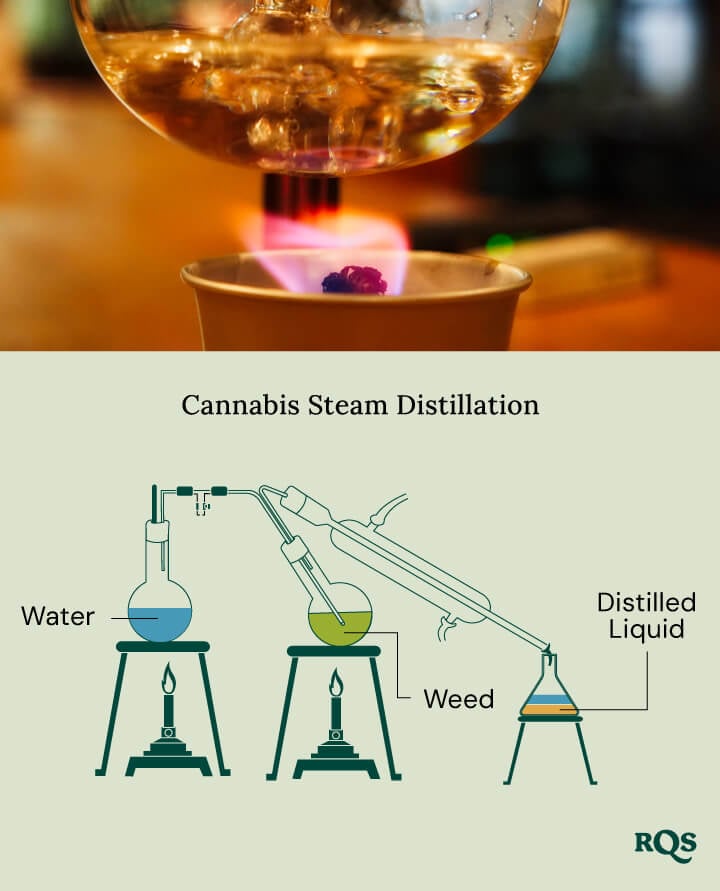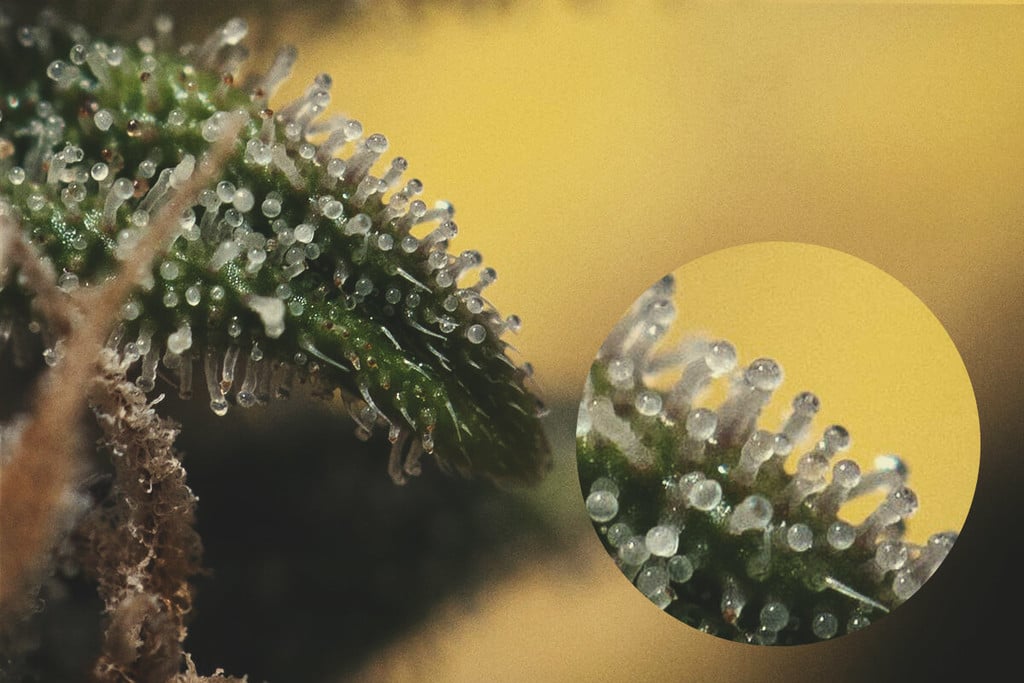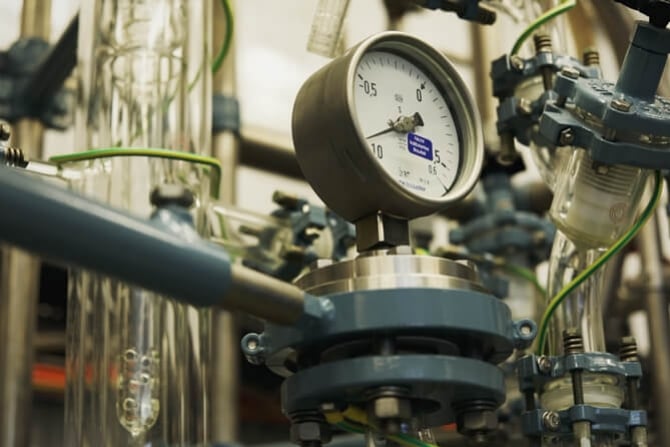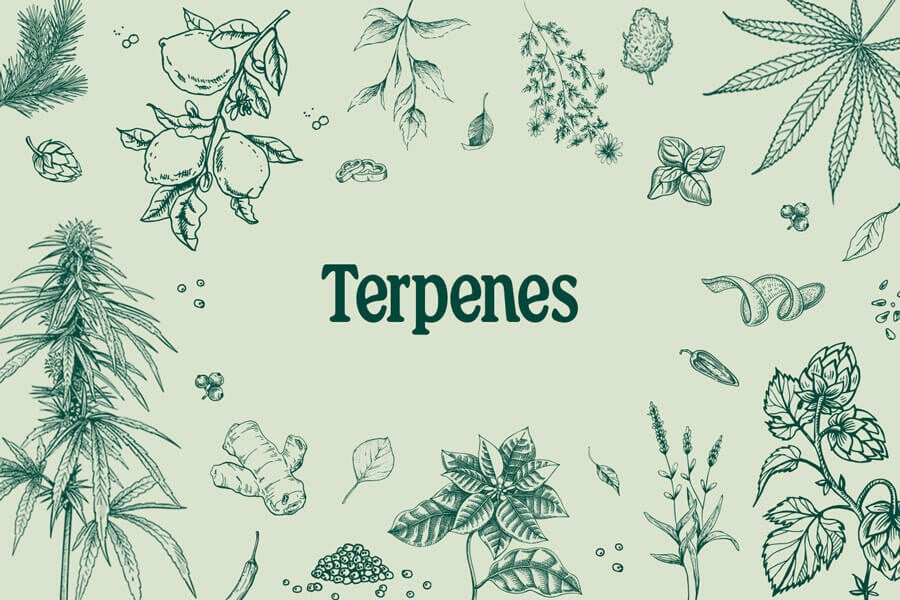.

Terpene Isolation & Extraction Methods: A Comprehensive Guide
Terpenes can be extracted and isolated from cannabis, then put to a very wide range of uses. The methods of extraction vary from extremely basic to highly complex, with some able to be performed at home and others requiring specialist equipment. Find out more below.
Terpenes and terpenoids exist throughout nature and are responsible for the vast majority of plant aromas. The diversity and mechanisms of these compounds are not fully understood, and they seem to work in weird and wonderful ways.
Still, terpenes are, and have always been, highly sought after for their scents. As such, a range of extraction processes exist to allow for this.With the normalisation of cannabis, more people are looking to this particularly fragrant plant as a source of terpenes. Here’s all you need to know about extracting them.
Contents:
Understanding Terpenes: The Aroma of Weed
Terpenes are the main compounds that give cannabis its diverse yet always recognisable aromas. The more this plant and its compounds are researched, the more we’re discovering about them.
It transpires that terpenes not only produce aromas, but can actually impact a person's mental state and physiology. Though they are not considered drugs in themselves, terpenes are not without effects. If you’ve ever wondered why lavender is relaxing or eucalyptus is refreshing, it’s largely down to the effects of terpenes.


The Significance of Terpenes in the Cannabis Industry
In the cannabis industry, it is true that terpenes are mainly sought after for their flavors and aromas. But more and more, people are also seeking out specific terpene ratios that are proposed to alter the effects of THC in beneficial ways. Some even now suspect that the differences in effects produced by different strains may well come down to differences in terpene ratios.
In fact, terpenes are so important that many cannabis cultivars are now desired chiefly for their flavor and not just their effect. Browse through the almost endless catalog of cannabis seeds available, and you’ll soon discover that what distinguishes many of them is how they taste, not how they affect the mind.
And now, breeders are deliberately experimenting with the different ways in which terpenes and cannabinoids interact, in hope of fine-tuning strains to exhibit specific effects.
Terpene Extraction and Distillation Methods: Why Are They Used?
Terpenes are often extracted from plants, including cannabis, in order to isolate the scents/flavors and use them in different products. They might be added to essential oil mixes, foods, perfumes, household cleaning products, or even other cannabis products.
While cannabis extracts generally contain terpenes and cannabinoids extracted from plant matter, terpene isolates contain no cannabinoids, only pure terpenes. Isolating terpenes can be difficult, but it does open the door to using them more freely—e.g. adding them to food or cannabis products.
Extracted terpenes may also be used for more nefarious purposes. Low-quality bud can be sprayed with extracted terpenes of any combination, and these can give it the flavor and aroma of top-quality cannabis flower. Now, flavoring cannabis with extra terpenes isn't necessarily a bad thing, but as a technique it can certainly be used to make cheap bud seem better, and therefore trick the buyer.
Terpene Isolation & Extraction Methods
Below we will outline a range of terpene extraction and isolation methods, starting with the simplest extraction methods (suitable for home use) and ending with more advanced isolation methods that require specific equipment and training.
-
Enfleurage
Enfleurage is a simple process that extracts terpenes from plant matter into fat. It can be performed “hot” or “cold”, with the former being quicker but more involved.
Cold enfleurage involves leaving aromatic plant material (cannabis flowers) in fat for 1–3 days, during which the terpenes will naturally be extracted. The longer you leave them, the better the extraction will be.
The hot process involves heating the fat until it melts then stirring in the cannabis flowers. This extraction is much faster. Once cooled, you are left with enfleurage pomade.
As many people desire pure terpenes, the fat can then be "washed" with a solvent to extract the terpenes from the fat.
-
Hot and Cold Pressing
This is the same process that’s used to make rosin, and essentially lands you with a cannabis concentrate; cannabinoids and all.
You can press raw flower, kief, or hash between rosin plates or hair straighteners, and the resin that runs off can then be collected. This resin contains concentrated terpenes and cannabinoids.
A hot press is more effective but degrades some terpenes, while a cold press is less effective but makes for a “cleaner” product.


-
Steam Distillation
Steam, at low temperatures and pressures, can be passed over cannabis to extract terpenes. When it condenses, it will contain the terpenes. However, due to the delicate nature of terpenes, there is a fine line between extraction and destruction. If the steam is too hot, or too pressurised, then the terpenes will instead break down and be lost.


-
Soxhlet Extraction
This method utilises distillation, percolation, and solvents. Plant matter is submerged in a solvent, which is then gently heated. The vapour runs through a percolator and then distils, and in this distilled solvent is a clean terpene extract.


-
Solvent Extraction
Solvents, such as ethanol, can also be used to extract terpenes. When cannabis is submerged in solvents, the terpenes will naturally begin to be extracted (stirring helps). This method is similar to that which is used to extract cannabinoids in order to make concentrates.
Solvents are helpful as they have low boiling points, meaning that they can be evaporated without damaging the chemical structure of the desired terpenes. Though the resulting products are not always the purest, solvent extractions are common in the cannabis industry as they are relatively simple and very effective.


-
Vacuum Distillation
This is a more advanced technique that you probably can’t perform at home. It involves heating and evaporating a solvent in a vacuum. This is beneficial because boiling points are lower in vacuums, and the lack of oxygen means heated terpenes will not oxidise. These two factors help to preserve terpene concentrations, improving the quality of the final product.
There are three main types of vacuum distillation: short path, fractional, and wiped film.
-
Pressurised Liquid Extraction (PLE)
This method applies pressure and heat to a solvent, which can aid the efficiency of extraction. Heat and pressure mustn’t be too high though, else the terpenes will be destroyed.
PLE is a useful method when efficiency is key, as it extracts a very high proportion of terpenes. It can be used with a range of different solvents, and must be adjusted to fit each one.
-
Ultrasound Assisted Extraction (UAE)
UAE is a highly interesting extraction method that works with water. By emitting ultrasound waves into water, it agitates tiny air bubbles and causes them to compress and rarefy, expanding their volume. As they rarefy, they join together, becoming larger. Once they reach a certain size, they violently implode with quite some force.
Anything in the vicinity of an imploding bubble will be affected, and plant tissue will burst, releasing its contents. Therefore, this method can be put to use for making clean, high-quality terpene extractions from cannabis.
-
Pulsed Electric Fields (PEF)
PEF is another non-thermal approach that helps to create high-quality products. The electronic pulses create irreversible permeations in cell membranes, making them porous and extracting their contents.
This technique is considered novel, with some sources even describing it as “avant-garde”.
-
Supercritical CO₂ Extraction
Supercritical CO₂ extraction is a very popular method of extraction for cannabinoids and terpenes. This method pumps supercritical CO₂ over a solid, extracting the desired compounds.
But what does supercritical mean? When CO₂ is heated to 31ºC and pressurised, it remains in a liquid form. This dense version of relatively hot CO₂ is highly effective for extracting compounds from solids.
The Many Methods of Terpene Isolation
As you can see, there are many ways to extract terpenes from cannabis plants. With the cannabis industry booming, and the terpene industry being age-old, there are plenty of new developments happening year after year—and more efficient and interesting methods are being developed to aid these processes! Mostly, extracted terpenes are put to good use. But occasionally, they may be used to add aroma and flavor to otherwise poor-quality bud, in an attempt to trick buyers into paying more. But for the time being, this doesn't appear to be so much of a problem.
Despite the complexity of contemporary extraction and isolation methods, simple and accessible ones exist, and you are perfectly able to make your own crude terpene extractions at home.







































